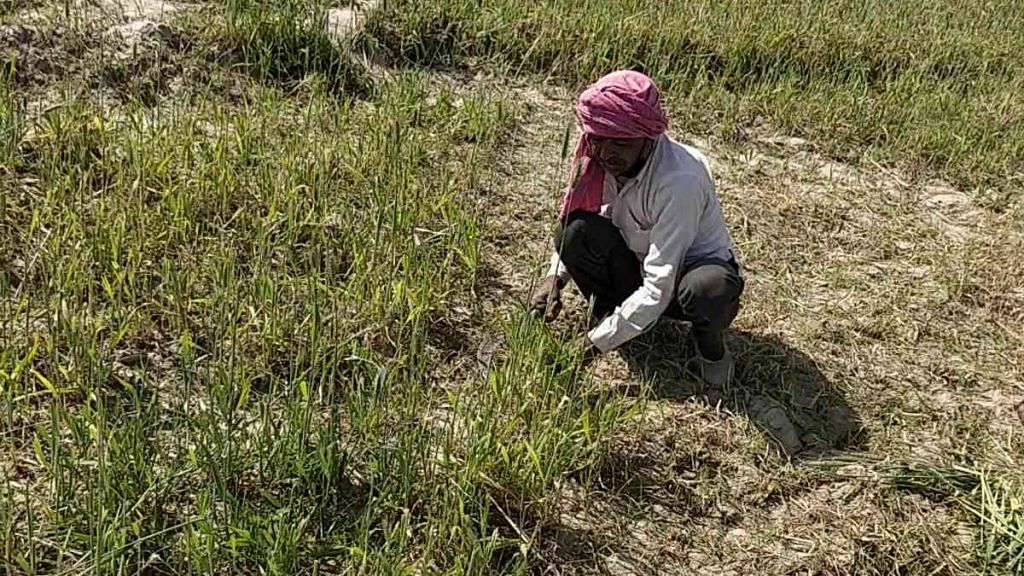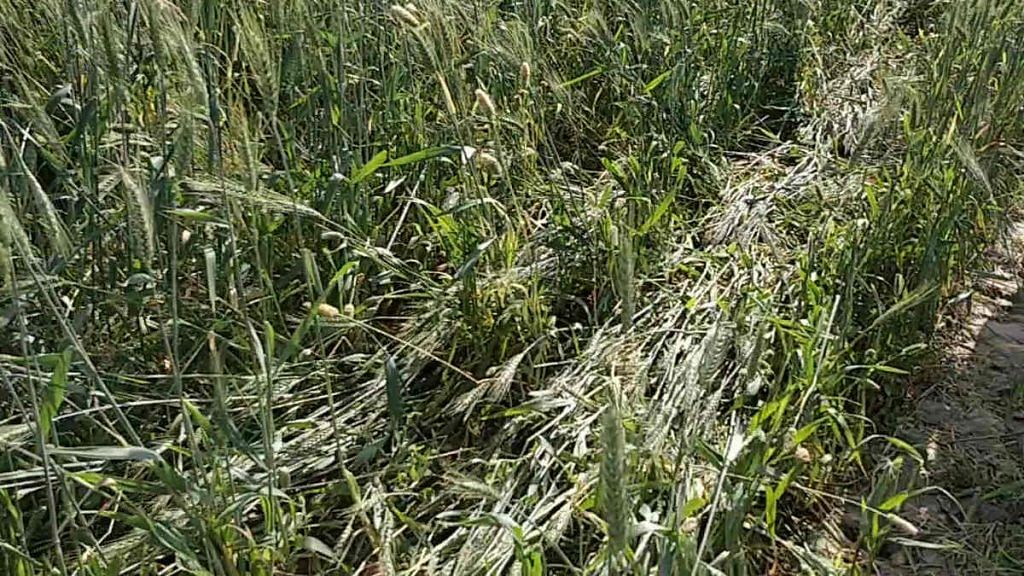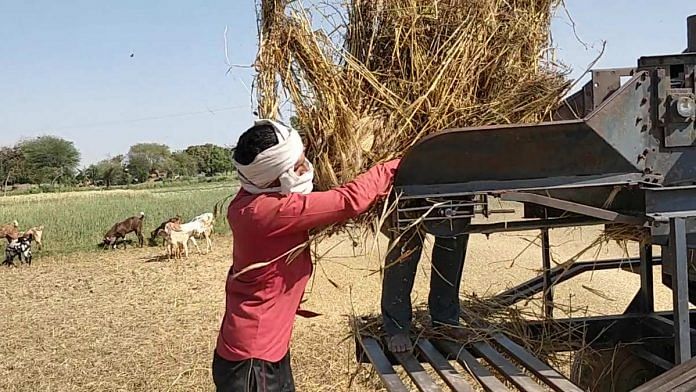Firozabad/Etawah/Sitapur: Chandra Pal Singh, a 48-year-old small farmer with three acres of farmland in Firozabad’s Usaini village, is harvesting what’s left of his wheat crop with his two sons and wife. Most of his crop was destroyed by stray cattle, and he says the family is left with just Rs 1,500 to survive, as his sons, who used to work at a local brick kiln, have lost their jobs under the nationwide coronavirus lockdown.
Singh has to finish cutting the remaining wheat, so that he can go and sell it with his other produce, bottle gourd, in neighbouring villages, as transporting it to the local mandi (wholesale market) is costly and time-consuming. Under the nationwide lockdown to curb the spread of the coronavirus, the mandi remains closed for most of the day, barring a few hours in the morning.
Harvesting the wheat also has another purpose for Singh — it will provide fodder for his cattle, as he can’t afford what is available in the market, because it is selling for three times the usual price.
“Forget nutritious feed, even basic straw, which used to cost Rs 180-200 per 30 kg, is now available at Rs 450. How will I feed three cows and half-a-dozen goats? It’s thanks to their milk and our produce that we have survived,” he told ThePrint.

“Most of my wheat and mustard has been devastated by hailstorms and stray animals from the nearby gaushala (cattle shelter),” he says, pointing to a line of trees whose barks have been damaged by hail.
Singh’s predicament is a familiar sight across small and medium farmers in rural Uttar Pradesh. The lockdown has worsened the crisis the farmers were already in due to low income, debt, weather and the menace of stray cattle that has rocked the state.
The farmers’ already-vulnerable situation has been worsened at both the input and output ends of their vocation — unavailability of diesel to run irrigation pumps, fodder for animals, steep fall in demand for their produce and disruption in marketing and supply chains. This is further aggravated by the lack of labour, accompanied by a shutdown of other agriculture-allied activities like the sale of livestock products, and the rural economy being brought to a standstill.
Also read: Agriculture, construction and manufacturing units get relief under new norms for lockdown 2
Sugarcane farmers’ plight
The districts of western Uttar Pradesh see a lot of wheat, mustard and sugarcane farming, the last of which is a very labour-intensive form of agriculture. But as soon as the lockdown was announced, this region too saw a mass exodus of labourers, who left for their villages in eastern UP, Bihar and Jharkhand. Local labourers were also unable to reach fields, weighing docks (dharam kantas) and mandis.
The transport mechanism that lifts produce from the farm to weighing docks and onwards to the mandis is either absent, or charging exorbitant prices, which small farmers can’t afford.
Bhola Ram, who holds five acres in Mahipalpur village, Mahewa block, Etawah, says like every other farmer in his village, he struggled in the initial days to get his sugarcane produce weighed and transported to the local mill. He is now waiting for the sugar mill to clear his dues, which run up to about Rs 70,000.
“I have sold around 320 quintals of sugarcane, but have only been paid for 180 quintals. The last time I got money was in January end,” Bhola Ram said.
“A mini truck, which used to charge around Rs 1,500 to transport sugarcane from the village to the mandi now charges around Rs 3,500,” he said.
Bhola Ram had to load his harvest in the truck by himself, and after eight days of labour, he could only transport 20 per cent of his produce to the mill.
Pradeep Shukla, a sugarcane and wheat farmer in Sakara, Sitapur, has also had to face losses due to stray cattle and the lack of labour. “The wheat crop I was growing on two bighas of land was destroyed by cows from the village gaushala. They ate more than half of my crops because they are getting nothing to eat after the lockdown, and the owner has set them free,” he complained.

Shukla is now trying to sow sugarcane, but that too is getting delayed due to the lack of availability of labour. “My five bigha of sugarcane farm used to be sowed by eight labourers in one day, but now there are only three labours available — they have sown the field in three days after I paid them double the normal amount,” he said.
Shukla said most of small sugarcane farmers used to sell their produce at local jaggery and khandsari sugar-producing units called kohlu that usually buy sugarcane at a lower rate than assured by the state, but provide much-needed cash to farmers compared to payments from sugar mills, which take months. As on 14 April, sugar mills in Uttar Pradesh owed farmers an amount of Rs 15,686 crore.
But these kohlus are also shut, said Shukla.
“The labour in jaggery units and other small village factories used to work in farms during the harvest and sowing season too. In the first few days of the lockdown, all of them went back to their villages. Now, even if the government wants, they won’t come back, leading to both cash and labour shortage,” he said.
Also read: How lockdown is disrupting the village economy in UP, one farmer at a time
Fruit and vegetable farmers worse-off
Then there are those small farmers who, under the burden of debt from private lenders, had switched to growing fruits and vegetables, which are considered a “guarantee” of quick and sizeable monetary returns, and are also promoted by the government.
Het Ram, a two-acre vegetable and fruit farmer in Barkatpur, Firozabad, is depending on his damaged potato produce for the survival of his family of six, as his fruits are selling for as low as Rs 5 per kg, while the cost of flour in the village has risen to Rs 38 per kg from Rs 17.
“Our potato produce was damaged in the hailstorm, and no one was ready to buy it, so we stored it in our home. Now, that’s all we’re eating with roti and salt. The money that comes from the fruit just goes in maintaining cattle,” Het Ram said.
Asked why he had stopped cultivating wheat, Het Ram said he used to sow wheat with government seeds, which used to cost around Rs 1,600 per kg. Generally, once farmers are done growing crops, they return to sell the new batch of seeds to the government. But a lot of times, the quality of these seeds is so bad that the government refuses to buy it, or the farmers get tangled in bureaucratic paperwork, making it impossible for them to go down this path.
Private sector seeds would cost Rs 2,800 per kg, which Het Ram couldn’t afford due to the Rs 2 lakh loan he had taken from a private lender at 48 per cent interest per annum.
Het Ram said he receives an amount of Rs 2,000 in his account under the PM-Kisan scheme, but his wife Kamla said it’s not enough for her to manage the home, considering the loan and the damaged crops.
And then, to add to the family’s troubles, came the novel coronavirus and the lockdown. “The mandi remains open until 7 am, and by the time I reached there, it was almost closing. My watermelon and cauliflower were sold for Rs 3 and Rs 8 per kg respectively,” he said.
“After paying for transport, I was left with just Rs 300, despite selling 140 kg of my produce. This money also went towards purchasing fodder, diesel for irrigation and a few kilos of flour and salt,” he added.
Also read: First, unseasonal rain and hail, now labour shortage: UP farmers’ troubles just keep piling up
Progressive farmers suffer too
Even those practising progressive farming, such as Nandu Singh from village Piswan in Sitapur, are suffering. Nandu owns polyhouse farming — which means growing crops under a controlled environment — worth lakhs of rupees, and grows capsicum and peppers.
But under the lockdown, the decline in demand and the consequent fall in prices has cost him Rs 10-15 lakh, he said.
“My produce was mostly procured from the mandi by restaurant and hotel owners from the neighbouring cities. But after lockdown, they are not able to make it to the mandi,” he said.
“My produce requires specific packing, along with transportation, which cost around Rs 30-35 per kg. But under the lockdown, my produce is selling for Rs 5-8 per kg. First, the hailstorm damaged my polyhouse by damaging its greenhouse roof, and now the lockdown is destroying us,” he added.
Also read: With 3% growth this year, India’s agriculture output will be a lone bright spot for economy







Terrible days ahead in our country. The beginning of the worst has just started.
Not worth reading. Looks to written from comfort of drawing room with imaginary narration just to create pessimism.